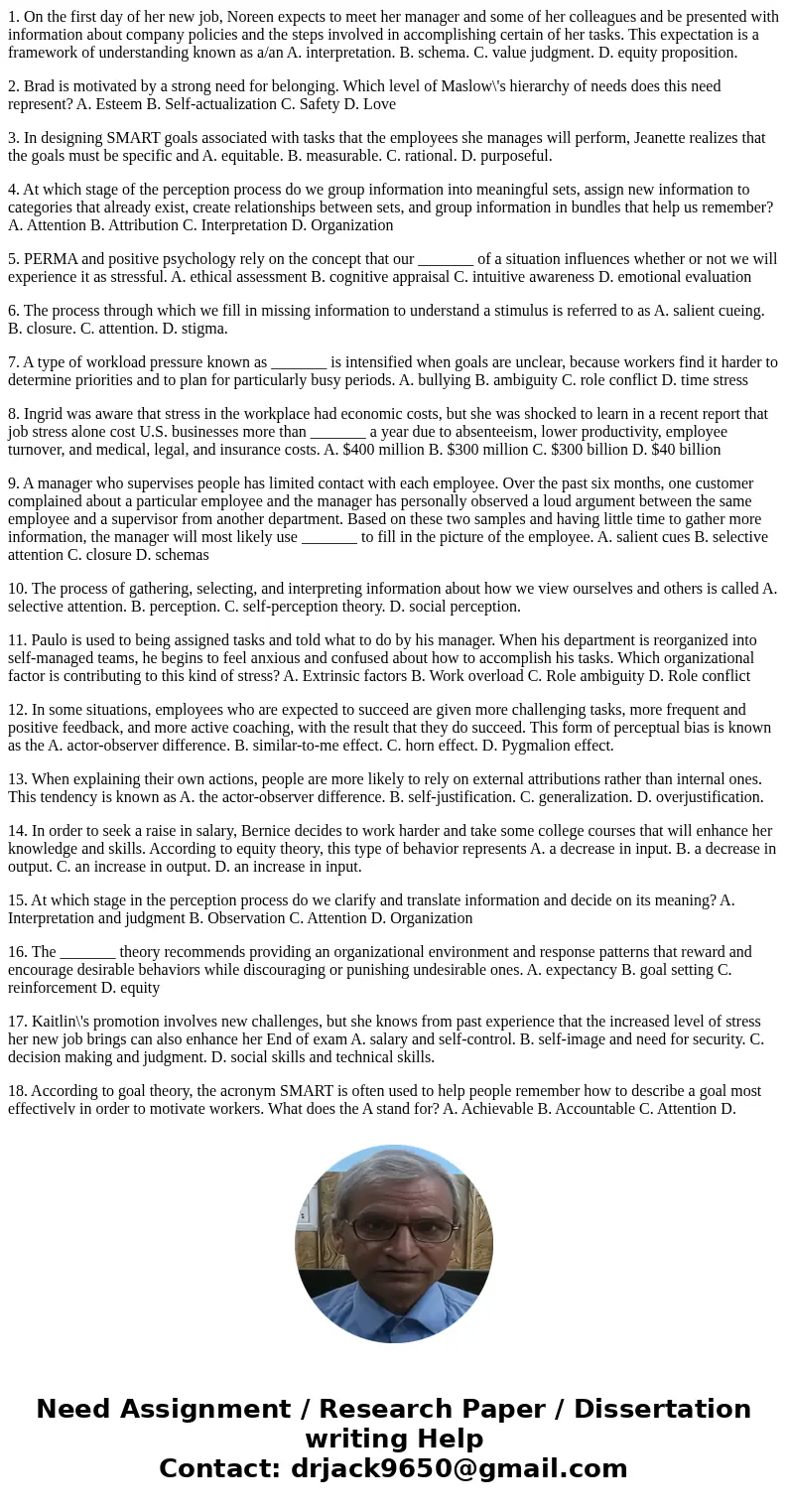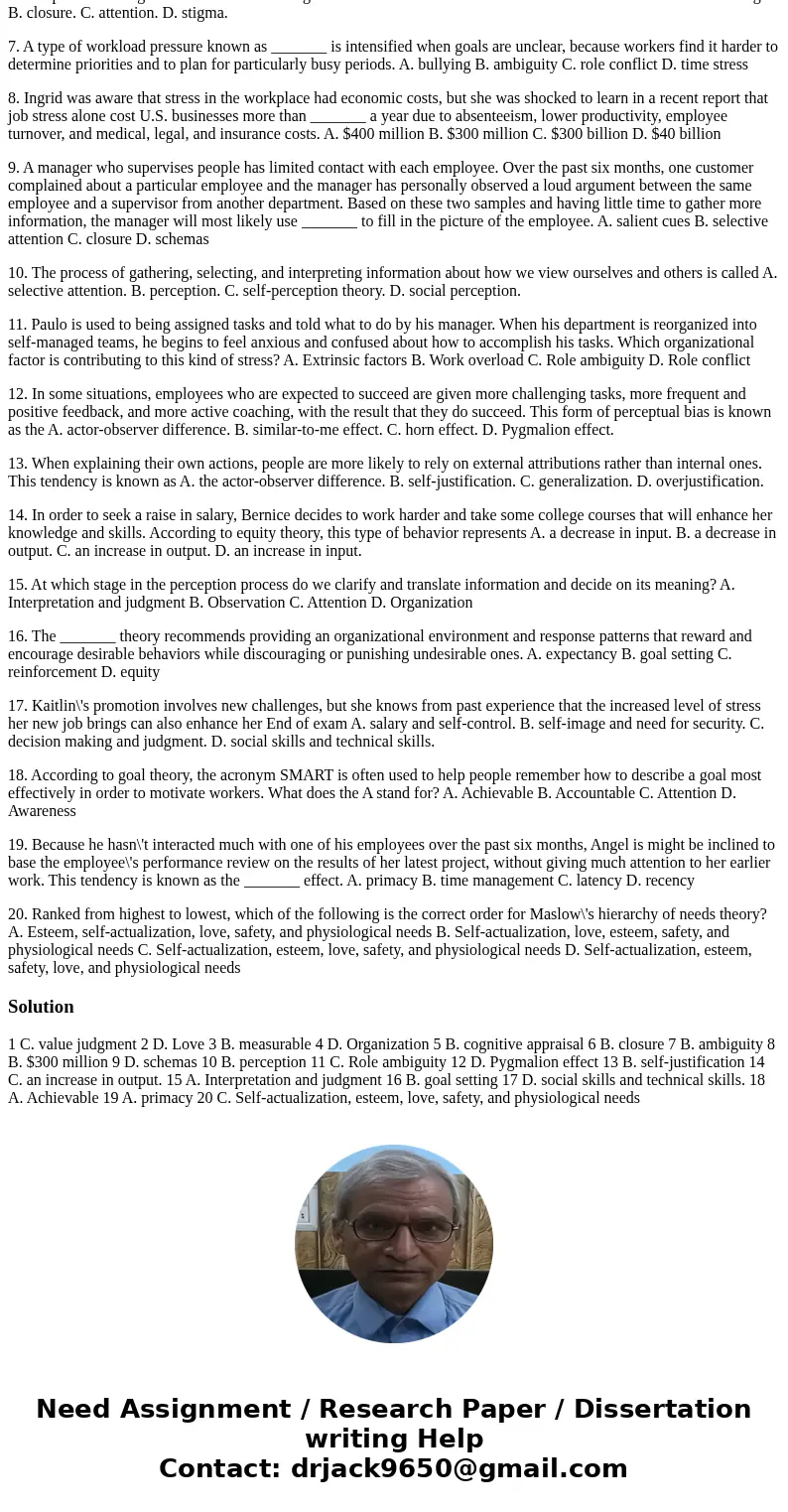1 On the first day of her new job Noreen expects to meet her
1. On the first day of her new job, Noreen expects to meet her manager and some of her colleagues and be presented with information about company policies and the steps involved in accomplishing certain of her tasks. This expectation is a framework of understanding known as a/an A. interpretation. B. schema. C. value judgment. D. equity proposition.
2. Brad is motivated by a strong need for belonging. Which level of Maslow\'s hierarchy of needs does this need represent? A. Esteem B. Self-actualization C. Safety D. Love
3. In designing SMART goals associated with tasks that the employees she manages will perform, Jeanette realizes that the goals must be specific and A. equitable. B. measurable. C. rational. D. purposeful.
4. At which stage of the perception process do we group information into meaningful sets, assign new information to categories that already exist, create relationships between sets, and group information in bundles that help us remember? A. Attention B. Attribution C. Interpretation D. Organization
5. PERMA and positive psychology rely on the concept that our _______ of a situation influences whether or not we will experience it as stressful. A. ethical assessment B. cognitive appraisal C. intuitive awareness D. emotional evaluation
6. The process through which we fill in missing information to understand a stimulus is referred to as A. salient cueing. B. closure. C. attention. D. stigma.
7. A type of workload pressure known as _______ is intensified when goals are unclear, because workers find it harder to determine priorities and to plan for particularly busy periods. A. bullying B. ambiguity C. role conflict D. time stress
8. Ingrid was aware that stress in the workplace had economic costs, but she was shocked to learn in a recent report that job stress alone cost U.S. businesses more than _______ a year due to absenteeism, lower productivity, employee turnover, and medical, legal, and insurance costs. A. $400 million B. $300 million C. $300 billion D. $40 billion
9. A manager who supervises people has limited contact with each employee. Over the past six months, one customer complained about a particular employee and the manager has personally observed a loud argument between the same employee and a supervisor from another department. Based on these two samples and having little time to gather more information, the manager will most likely use _______ to fill in the picture of the employee. A. salient cues B. selective attention C. closure D. schemas
10. The process of gathering, selecting, and interpreting information about how we view ourselves and others is called A. selective attention. B. perception. C. self-perception theory. D. social perception.
11. Paulo is used to being assigned tasks and told what to do by his manager. When his department is reorganized into self-managed teams, he begins to feel anxious and confused about how to accomplish his tasks. Which organizational factor is contributing to this kind of stress? A. Extrinsic factors B. Work overload C. Role ambiguity D. Role conflict
12. In some situations, employees who are expected to succeed are given more challenging tasks, more frequent and positive feedback, and more active coaching, with the result that they do succeed. This form of perceptual bias is known as the A. actor-observer difference. B. similar-to-me effect. C. horn effect. D. Pygmalion effect.
13. When explaining their own actions, people are more likely to rely on external attributions rather than internal ones. This tendency is known as A. the actor-observer difference. B. self-justification. C. generalization. D. overjustification.
14. In order to seek a raise in salary, Bernice decides to work harder and take some college courses that will enhance her knowledge and skills. According to equity theory, this type of behavior represents A. a decrease in input. B. a decrease in output. C. an increase in output. D. an increase in input.
15. At which stage in the perception process do we clarify and translate information and decide on its meaning? A. Interpretation and judgment B. Observation C. Attention D. Organization
16. The _______ theory recommends providing an organizational environment and response patterns that reward and encourage desirable behaviors while discouraging or punishing undesirable ones. A. expectancy B. goal setting C. reinforcement D. equity
17. Kaitlin\'s promotion involves new challenges, but she knows from past experience that the increased level of stress her new job brings can also enhance her End of exam A. salary and self-control. B. self-image and need for security. C. decision making and judgment. D. social skills and technical skills.
18. According to goal theory, the acronym SMART is often used to help people remember how to describe a goal most effectively in order to motivate workers. What does the A stand for? A. Achievable B. Accountable C. Attention D. Awareness
19. Because he hasn\'t interacted much with one of his employees over the past six months, Angel is might be inclined to base the employee\'s performance review on the results of her latest project, without giving much attention to her earlier work. This tendency is known as the _______ effect. A. primacy B. time management C. latency D. recency
20. Ranked from highest to lowest, which of the following is the correct order for Maslow\'s hierarchy of needs theory? A. Esteem, self-actualization, love, safety, and physiological needs B. Self-actualization, love, esteem, safety, and physiological needs C. Self-actualization, esteem, love, safety, and physiological needs D. Self-actualization, esteem, safety, love, and physiological needs
Solution
1 C. value judgment 2 D. Love 3 B. measurable 4 D. Organization 5 B. cognitive appraisal 6 B. closure 7 B. ambiguity 8 B. $300 million 9 D. schemas 10 B. perception 11 C. Role ambiguity 12 D. Pygmalion effect 13 B. self-justification 14 C. an increase in output. 15 A. Interpretation and judgment 16 B. goal setting 17 D. social skills and technical skills. 18 A. Achievable 19 A. primacy 20 C. Self-actualization, esteem, love, safety, and physiological needs

 Homework Sourse
Homework Sourse